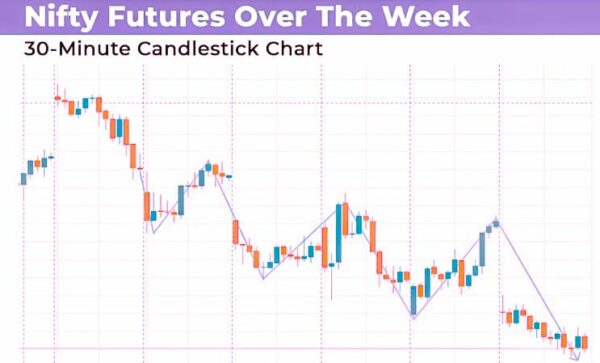Nifty50 Fundamentals | Rise and Fall Away?

Bullish traders for Nifty had yet another bad week. Started slow and slowed even more as the game progressed, resulting in a bad finish. I’m not sure where I first heard that song. Oh, yes, we’ve been singing that song for a while now, around eight months to be precise. In the interim, we were able to hum several beats of a boisterous melody, and several of us joined in a chorus, hoping that this would persist.

The market, on the other hand, had no such actual plans. It had a resolutely downward route throughout the week, as evidenced by the week’s intraday chart, which shows a definite lower-top and lower-bottom pattern. For more information, click here.
What is our current knowledge of Nifty?
As we go to basics, The Nifty is the main benchmark of the National Stock Exchange (NSE), and it is a well-diversified index that includes the top 50 businesses listed on the exchange in terms of free-float market capitalization. In all market situations, it is expected to represent the strength of the declared universe of Indian firms, and hence the greater economy.

The index, which is popularly and officially known as the Nifty50, is calculated using the float-adjusted market capitalization approach, which is simply the account of shares in actual circulation in the marketplace at any particular given time.
The Nifty, like the BSE benchmark Sensex, is now utilized for evaluating mutual fund portfolios and results, as well as launching index products.
The Nifty index was first published on April 22, 1996, with a 1,000-point base value starting on November 3, 1995. At any moment, live Nifty quotations are available on NSEIndia.com and a variety of other digital platforms and television networks.
The Nifty indexes are administered by India Index Services & Products Limited (IISL) a Mumbai-based subsidiary of the National Stock Exchange. The board of directors, the index policy committee and the index maintenance sub-committee make up IISL’s three-tier governance structure. As of September 30, 2016, IISL maintained 67 indexes under the Nifty brand.
The Nifty index is rebalanced semi-annually by IISL. The deadlines for the index’s semi-annual assessment are January 31 and July 31 each year. The average results for the six months leading up to the cut-off date are taken into account. Any alteration in the index is notified by the exchange four weeks before it takes effect.

The qualifying criteria for selecting Nifty member equities are well-defined. The general market movements cost, which is simply the cost of transacting a stock, is used to determine a stock’s liquidity. A stock really should have traded at an approximate cost of 0.50 percent or less for 6 months and 90% of observation instances to qualify for participation in the Nifty50.
Furthermore, the firm must have been listed for at least six months. However, a newly-listed firm that has recently gone public through an initial public offering (IPO) may be eligible for participation in the index provided it meets the regular eligibility criteria for three months rather than six months.
Only companies that may be traded on the NSE’s F&O section are evaluated for consideration as Nifty members.
The financial industry accounted for 35.73 percent of the Nifty as of September 20, 2017, followed by the energy sector at 14%, the information technology industry at 11.46 percent, and the car industry at 10.64 percent, and the consumer goods sector at 10.13 percent. Six of the Nifty50’s nine BFSI businesses were private banks.
Nifty Junior, Nifty50 USD, Nifty50 Total Returns index, and NIFTY50 Dividend Points Index are all variations of the Nifty index.
Technical Chart & Study over the week:
The question that should be asked is whether or not there has been any price erosion. No, that is not the case. So, we’re back to where we’ve been for the past few weeks. Since the high of October 2021, we’ve gone through many parts of the transition, and some may be inclined to say, “Tell me something I don’t know!” There isn’t much new to say in terms of analysis.
But, even if it is the truth, we all find it amusing or even obscene to state that we have no opinion on the market right now. In a blog article on predicting approximately a year ago, I went into great length about this. It’s the type of thing we feel obliged to do, and it’s referred to as mimetic behavior.

And besides, why do publications, blogs, analysts, experts, and the like exist if not to provide predictions to the general public? So, with all that in view, here is this week’s arcane material. I’ve created several price cycle lines in the graph in the article and highlighted them with grey and red dashed lines.
If you look closely, you’ll find that the market moves in a cycle produced by the grey lines. The downturn began around this cycle line on April 5, 2022, sank to a low on April 19, recovered back to the upper cycle line until April 29, and then continued the slide.
By May 12, the following segment had descended to another grey cycling line. It bounced back and forth between two of these cycle lines until May 26, when it created a reversal candle pattern and began a rally.
So far, everything has gone well. The next rise should have encountered another similar cycle line, which was positioned at 16,400 and eventually over 16,900. This range structure breakout gave us a target higher around those levels, as we stated in a previous letter. Now we see that the index has failed to reach those levels, instead of stopping short of them.

Likely conclusion: What role should traders play in these scenarios? What’s the use of predicting if you can’t put it to use? To some, this may appear to be no prediction at all, with so many ifs and buts. People who believe this way seek certainty from projections, which is a poor approach because everything connected to the future could only be considered as a likelihood.




